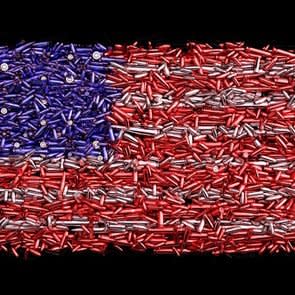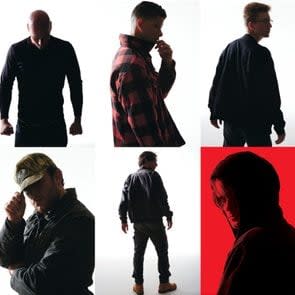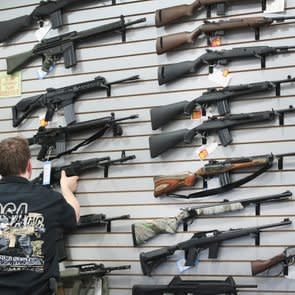Gun Violence Statistics in the United States: 12 Charts You Need to See
Defined most commonly as any shooting in which four or more people—not including the perpetrator—are injured or killed, mass shootings happen every day in America, and sometimes more often. In 2019, there were 417 such assaults. In 2020, there were 610—nearly two mass shootings per day—killing 513 people and injuring 2,543. But mass shootings represent a tiny fragment of the problem. Nearly 20,000 people were murdered by guns last year, and another 40,000 injured. That doesn’t even account for the approximately 24,000 suicides by gun in 2020. Another way to look at it: Guns are involved in 75 percent of all murders and 51 percent of all suicides. The following gun violence statistics tell more of the story.
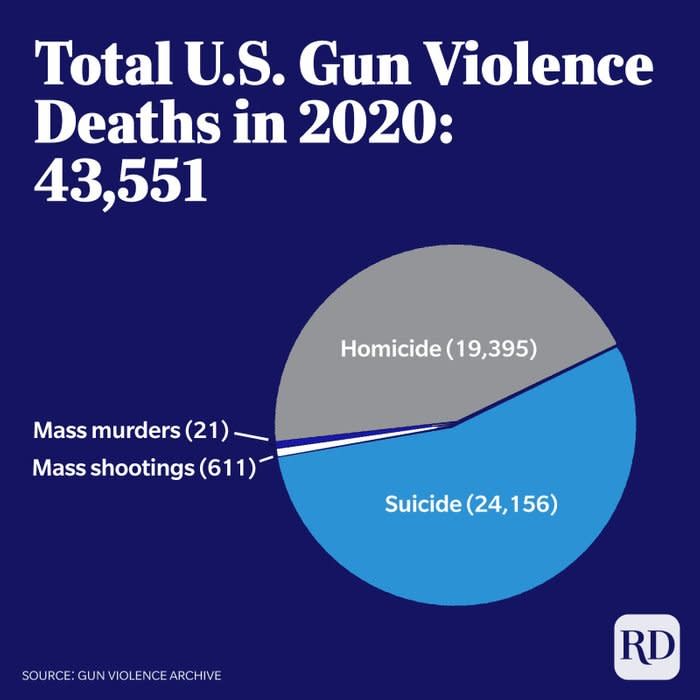
Snapshot of gun violence in America
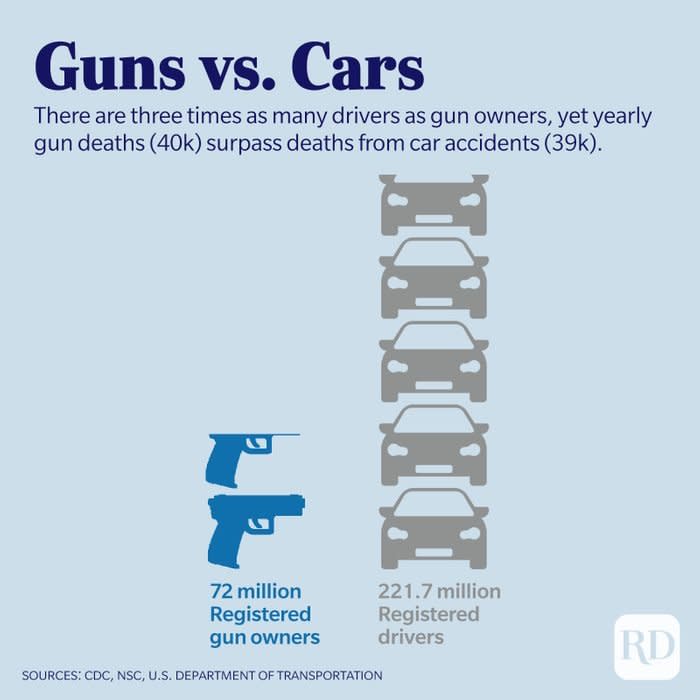
The nearly 40,000 Americans killed each year since 2016 by gun violence exceed the number of people killed by car accidents (39,000), despite the fact that in 2017 there were 221.7 million licensed drivers, and only 72 million registered gun owners.
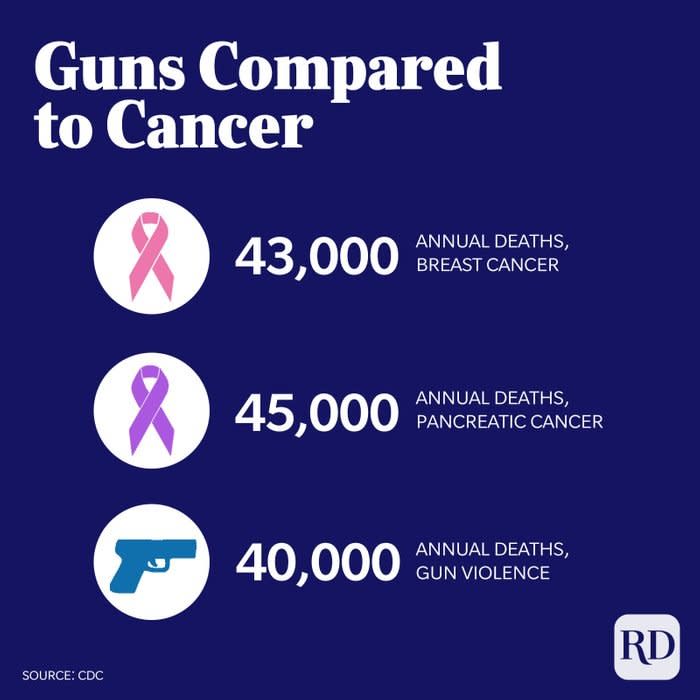
The number of Americans killed by guns (nearly 40,000) is on par with those who die from breast cancer (43,000) and pancreatic cancer (45,000), according to the U.S. Centers for Disease Control and Prevention data from 2018.
America loves guns
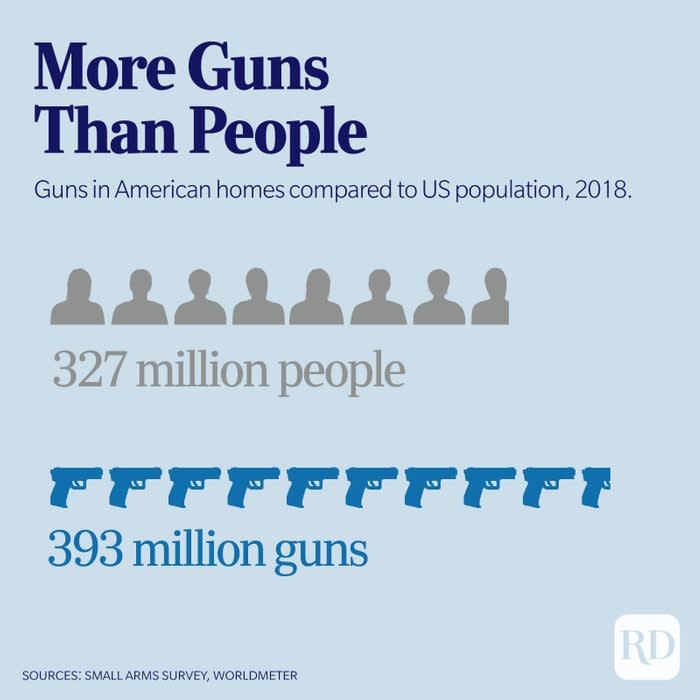
In 2018, the Small Arms Survey reported that 393 million guns were in American homes; that’s more guns than America has people. The population of the United States stood at 327 million people in 2018, according to Worldmeter.
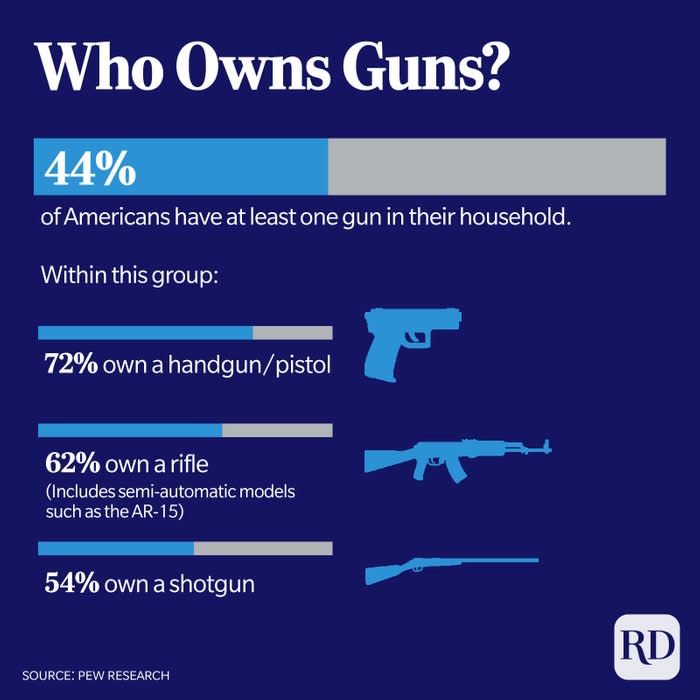
In 2020, 44 percent of Americans reported that they or someone in their household owned a gun, per a Gallup poll. According to a 2017 poll by Pew Research, gun owners are most likely to be male, White, live in a rural area, and not be college graduates. About two-thirds of gun owners have more than one and, at least statistically speaking, the average gun owner has eight firearms.
Most gun owners have a handgun or pistol (72 percent). The next most popular type is a rifle (62 percent), followed by a shotgun (54 percent). Gun classifications are broad, and the “rifle” designation includes semiautomatic weapons like the AR-15. In 2016, this style comprised more than 60 percent of all rifles sold.
About 40 percent of gun owners have at least one gun that is loaded and easily accessible to them at all times, and 63 percent say they have at least one gun that is never locked up. One ex-gunman tells us how to stop the next mass shooter.
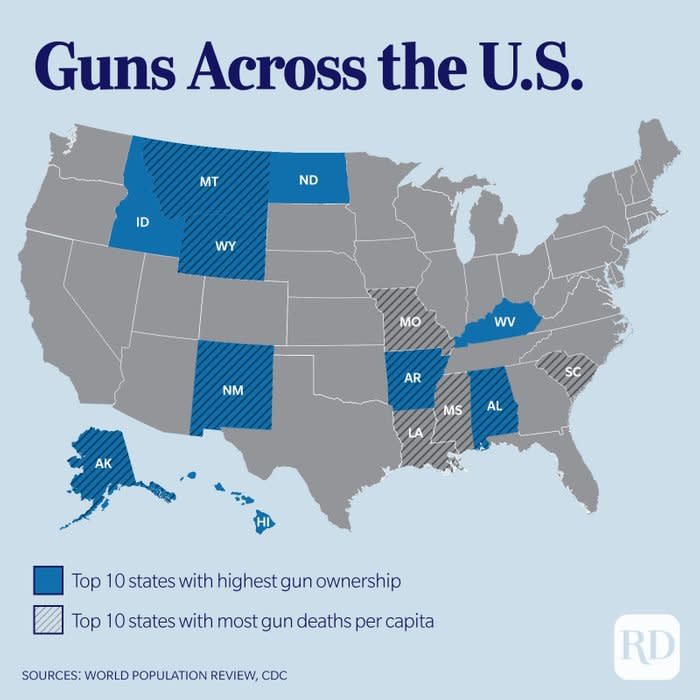
Gun ownership per capita varies by state. The top ten states for gun ownership in 2021 are:
Alaska (61.70 percent)
Arkansas (57.90 percent)
Idaho (56.90 percent)
West Virginia (54.20 percent)
Wyoming (53.80 percent)
Montana (52.30 percent)
New Mexico (49.90 percent)
Alabama (48.90 percent)
North Dakota (47.90 percent)
Hawaii (45.10 percent)
Source: World Population Review
In 2019 gun deaths per 100,000 residents were highest in the following states:
Alaska 24.4
Mississippi 24.2
Wyoming 22.3
New Mexico 22.3
Alabama 22.2
Louisiana 22.1
Missouri 20.6
South Carolina 19.9
Arkansas 19.3
Montana 19.0
RELATED: I Got Shot in a Place That Loves Guns, and I Still Can’t Bring Myself to Hate Guns
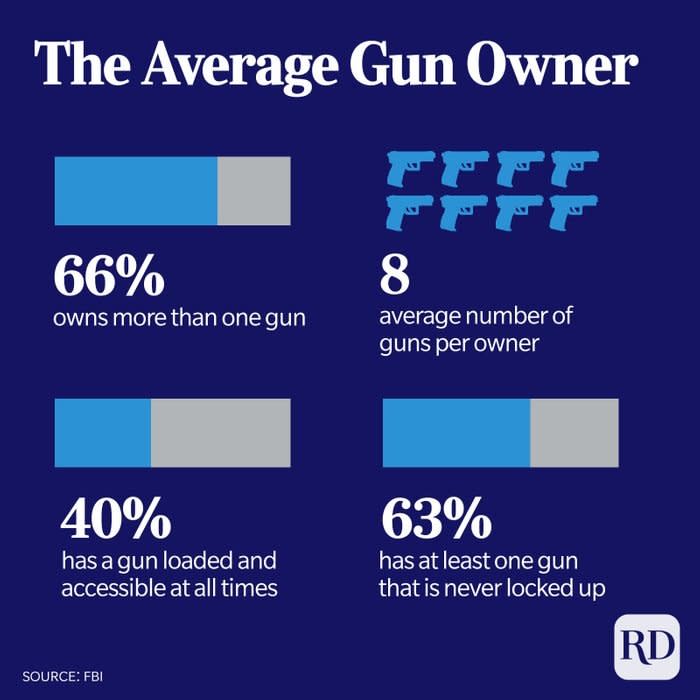
Guns most commonly used in shootings
Though “assault” weapons make most of the headlines, they were responsible for only 32 percent of the deaths in mass shootings from 2009 to 2018. At least one handgun is used in an overwhelming majority of mass shootings (81 percent), and in a lesser majority (60 percent) mass shootings, only a handgun is used, but often in combination with a high-capacity magazine.
In “ordinary” shootings, handguns remain the most common type of weapon used, accounting for 62 percent of homicides in 2019. Still, AR-15 and similar weapons cause more deaths more quickly than other types of firearms and were used in the deadliest of America’s mass shootings, including Las Vegas (58 people killed), Orlando (49 people killed), and in Newtown, Connecticut (27 people, mostly children, killed).
America stands alone in its gun love
While America is armed with 120.5 guns for every 100 residents, the figures for all other countries are far lower. The countries with the next-highest rates of gun ownership are Yemen (52.8 guns per 100 population), Serbia (39.1/100), Montenegro (39.1), and Uruguay (also 34.7). Canada follows with 34.7 guns per 100 people—less than a third of the gun ownership rate of Americans. In fact, the United States accounts for 4.4 percent of the world’s population but owns 42 percent of the guns in the world. Other countries, such as Italy, also have gun cultures, but mass shootings there are rare.
In 2017, the United States ranked 28th among the world’s highest rates of gun death, with 4.43 per 100,000 people. The countries that ranked higher, including El Salvador, Venezuela, Guatemala, Honduras, and Jamaica, are largely those struggling with drug trafficking and gang activity, said Ali Mokdad, a professor of global health and health metrics science at the Institute for Health Metrics and Evaluation. But when compared to only high-income countries, the United States ranks first, with more than twice as many gun-related homicides per 100,000 people as its nearest “competitor,” Chile.
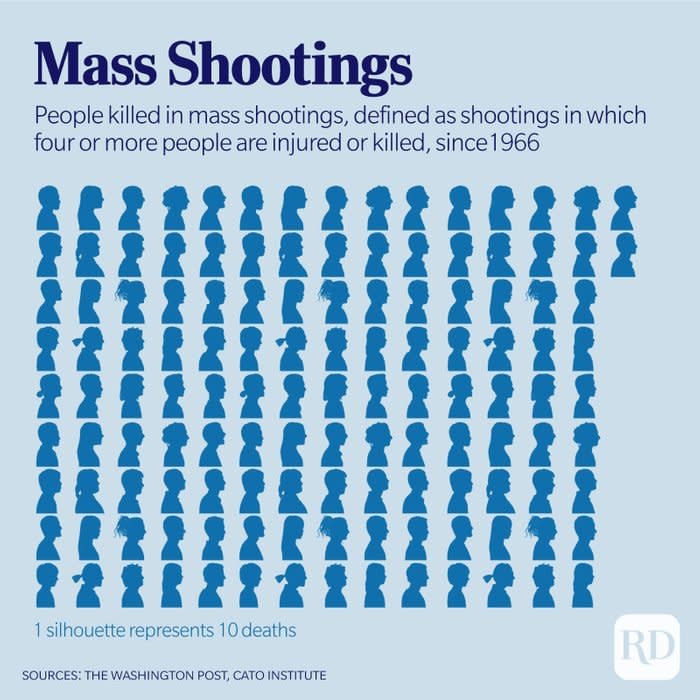
The first mass shooting occurred in 1966 when a sniper at the University of Texas killed 17 people from his perch in a clock tower. Since then, as of May 1, 2021, 1,316 people have been the victim of a mass shooting. While the pace of mass shootings has not increased substantially in the last several years, their death toll has. From 2009 to 2018, the average number of people shot in such incidents rose from seven to 13.
Despite common perceptions, the majority—61 percent—of mass shootings (those killing or injuring more than four people) happen in private homes, not public spaces. And despite their attention-grabbing headlines, mass shootings account for a tiny fraction of all homicides in the United States—in 2019, they made up about one in every 400 gun-related deaths. Read more undeniable facts about mass shootings.
Source: The Washington Post, Cato Institute
Who is most affected by gun violence?
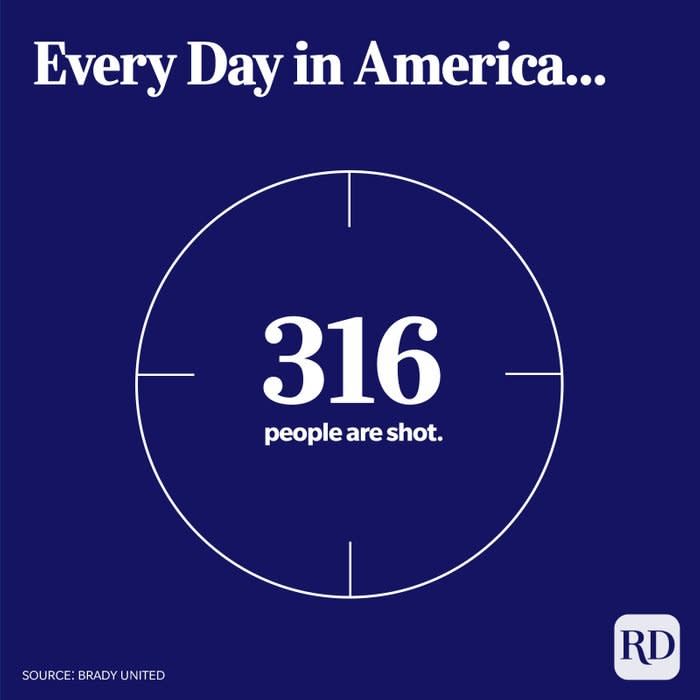
On average between 2013-16, every day in America, 316 people are shot. More than 100 of them die each day.
In the United States, Black men are 15 times more likely to be hurt or killed by a gun than their White, Asian, Hispanic, or other ethnic counterparts. Black men are the victims in 52 percent of gun-related homicides in America, though they represent just 7 percent of the population.
But women and children, too, are often looking down the barrel of a gun. Guns are used in about 56 percent of intimate partner homicides. Guns are the second-leading cause of death for children under 18 (behind car accidents but ahead of cancer). About a third of households with kids have a gun.
Almost half of all Americans (44 percent) know someone who has been shot. Nearly every American will know at least one victim of gun violence during their lifetime In comparison, the likelihood that any individual will be shot in Singapore—the country with the lowest gun fatality rate in the world—is calculated to be one in a million. In Japan, it goes up to two in a million. In America, it rockets to 1,060 in a million. At least one survivor wishes people would move beyond thoughts and prayers.
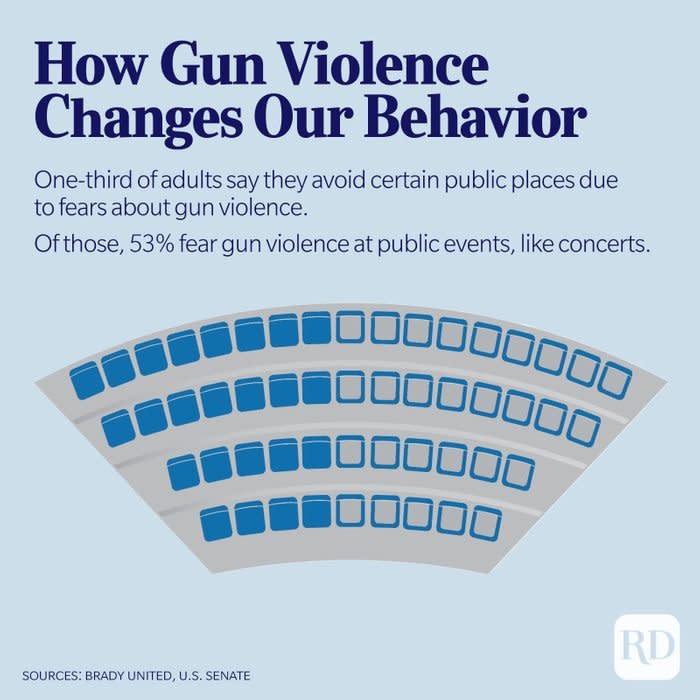
Survivors of gun violence often pay a high price. Often, people who have been shot experience post-traumatic stress disorder, unemployment, and drug and alcohol abuse. Among those who have witnessed a mass shooting, an estimated 28 percent develop PTSD.
Even those who have never experienced gun violence directly are affected. In 2019, a survey by the American Psychological Association revealed that 79 percent of adults feel stressed about the possibility of a mass shooting, and 33 percent say they avoid going to certain public places due to fears about gun violence.
RELATED: What Happens to Survivors of Mass Shootings?
One of the most surprising gun violence statistics may be how it affects our economy. A 2019 report from the U.S. Congress Joint Economic Committee concluded that the costs of lost income, employer costs, health care, and police and criminal justice expenses due to gun violence amount to a staggering $229 billion—every year.
The role of the gun industry
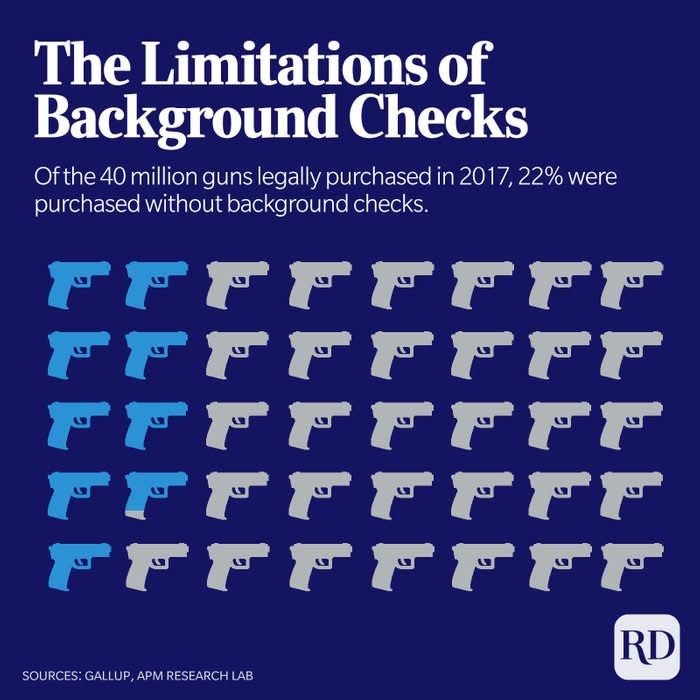
Nearly 40 million guns were sold in the United States in 2020, setting an all-time record. Yet, in 2017, an estimated 22 percent of current gun owners purchased their most recent firearm without a federal background check. Much of that is due to the so-called “gun show loophole” in federal law. Unlicensed dealers—those who sell guns in private transactions or online, as well as at gun shows—are exempt from conducting background checks on their buyers. This loophole means that people with previous violent crime convictions, those with severe mental health conditions, and others who would legally be restricted from purchasing a gun from a licensed dealer can buy a weapon with no questions asked.
Complicating matters further is the rise of “ghost guns”—firearms that can be 3-D printed or assembled at home from parts or a kit, with no serial numbers, rendering the weapons untraceable—and very appealing to those who can’t pass background checks. In 2019, law enforcement recovered about 10,000 ghost guns. That same year, the Bureau of Alcohol Tobacco and Firearms reported that nearly a third of all weapons recovered from crimes in California were ghost guns. President Joe Biden announced in early April that he would direct the Justice Department to propose a rule to curb ghost gun production.
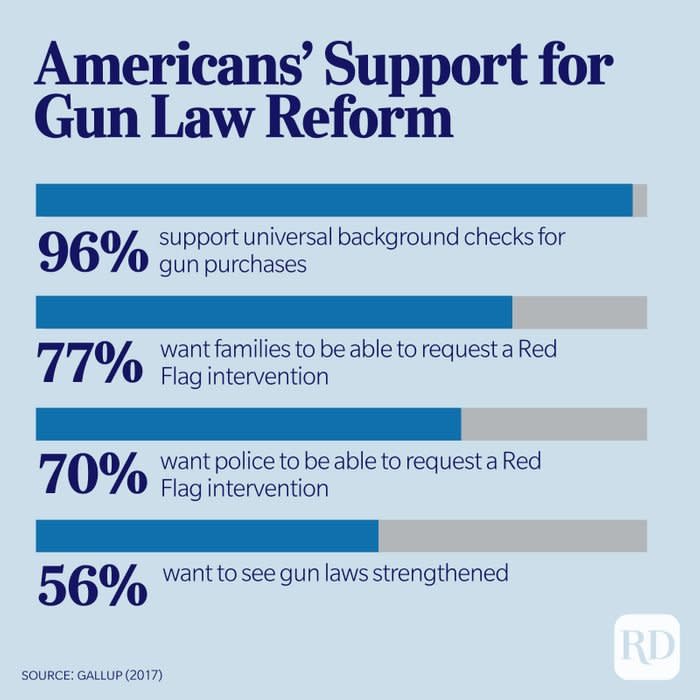
Though Americans have been polarized on many issues in recent years, they almost universally agree on the importance of universal background checks. In a 2017 Gallup poll, 96 percent of Americans surveyed said they support requiring background checks for all gun sales.
Red flag laws, sometimes known as extreme risk protection orders (ERPOs), let family members or police petition a judge to remove guns from a person they believe to be at high risk for injuring themselves or others. Currently, such laws are on the books in 19 states and enjoy broad support. Seventy-seven percent of Americans want family to be able to request a red flag intervention, and 70 percent say police should be able to. President Biden announced in late April that the Justice Department would issue a model red flag law for states to use in creating their own legislation.
Support for “stricter” laws governing the sale of firearms in general is less robust, however. In 2020, only 57 percent of people Gallup surveyed wanted to see laws strengthened—down from 64 percent the previous year—while 34 percent want current laws to remain in place. Nine percent of people think gun laws should be less strict than they are now.
Sources:
Pew Research Center: “What the data says about gun deaths in the U.S.”
NSC: “Motor Vehicle Deaths Estimated to Have Dropped 2% in 2019”
U.S. Department of Transportation: “Older Drivers Set Record For Second Year”
U.S. Centers for Disease Control and Prevention (CDC): Firearm Violence Prevention Americans killed by gun violence in 2018
CDC: National vital Statistics Report
Small Arms Survey: Annual Report 2018
Pew Research Center: “America’s Complex Relationship With Guns”
Worldometer: U.S. Population https://www.worldometers.info/world-population/us-population/
Ali Mokdad, a professor of global health and health metrics science at the Institute for Health Metrics and Evaluation
CDC: Firearm Mortality by State
FBI: 2019 Crime in the United States
The Washington Post: “The terrible numbers that grow with each mass shooting”
CATO Institute: “Are Mass Shootings Becoming More Frequent?”
Brady United: Key Statistics
Giffords Law Center: Statistics
Seattle Times: “In some countries, the odds of getting shot are 1 in a million. In the U.S., it’s 1,000 times higher.”
Pew Research Center: “Guns and daily life: Identity, experiences, activities and involvement”
Children’s Defense Fund: The State of America’s Children® 2021
APA: “What happens to the survivors”
APA: “One-Third of US Adults Say Fear of Mass Shootings Prevents Them from Going to Certain Places or Events”
Senate Joint Economic Committee: “A State-by-State Examination of the Economic Costs of Gun Violence”
Giffords Law Center: Universal Background Checks
The Trace: “Ghost Guns Are Everywhere in California”
The New York Times: “Ghost Guns: What They Are, and Why They Are an Issue Now”
Gallup: Guns
APM Research Lab: AMERICANS’ VIEWS ON KEY GUN POLICIES
Why Is It So Hard to Stop Gun Violence in America?
Ex-Gunman Tells Us How to Stop the Next Mass Shooter
Here's Why Gun Makers Are Off the Hook for Mass Shootings
The post Gun Violence Statistics in the United States: 12 Charts You Need to See appeared first on Reader's Digest.
